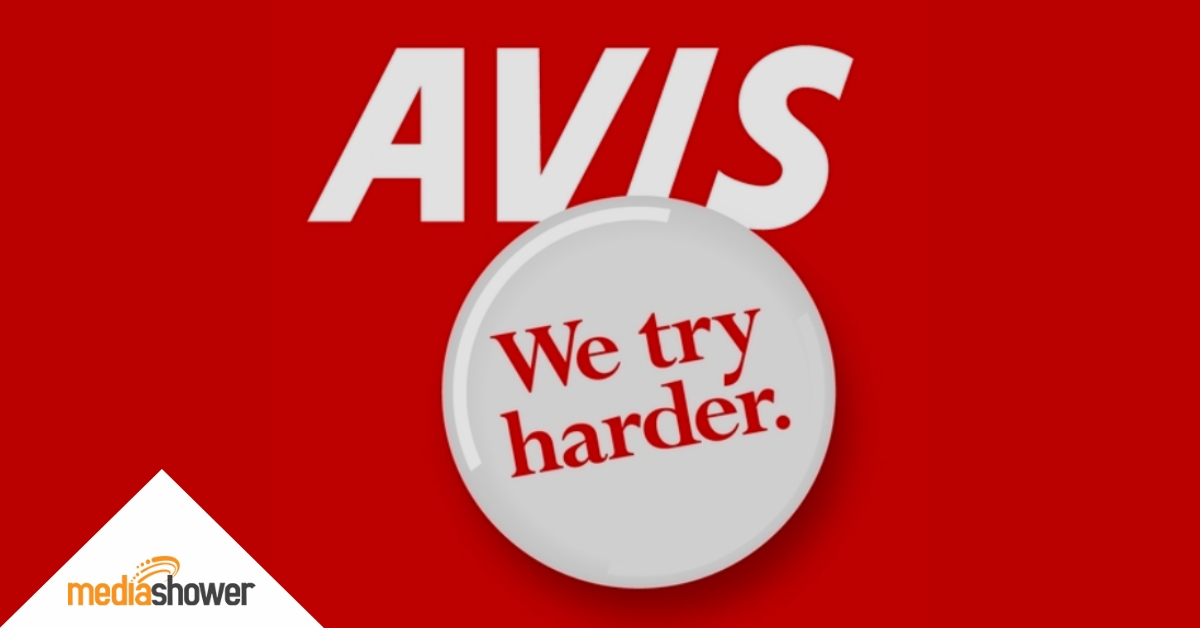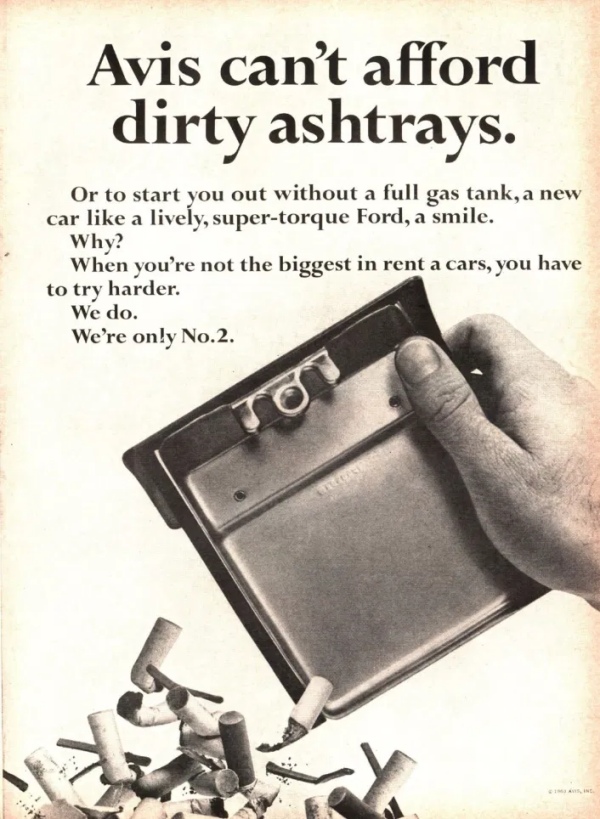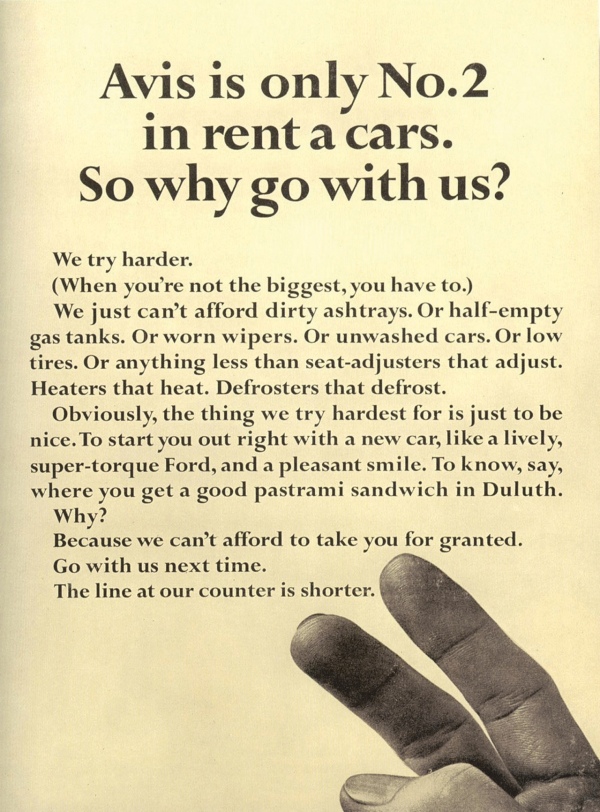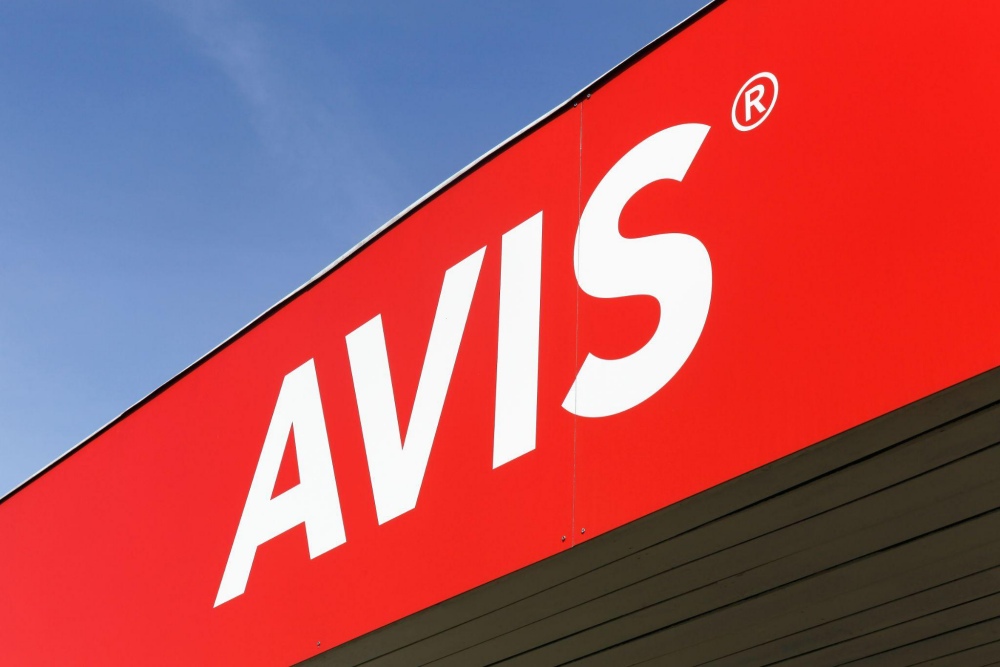
In 1962, Hertz was the #1 rental car company in America, and it wasn’t even close. Hertz held about 61 percent of the market, while Avis trailed with 29 percent. That gap kept Avis struggling financially and reputationally.
Today, many companies find themselves in a similar position, trailing far behind competitors. Conventional advice is to hide that weakness. Yet Avis chose to lean into it, setting the stage for one of history’s most effective ad campaigns.
Here’s what marketers today can learn from Avis’s brilliant campaign, “We Try Harder.”
Background
In the 1960s, advertising was glossy, overpromising, and impersonal—all things that Avis was not.
In this polished bubble, brands leaned on glamorous photography, booming announcers, and lofty promises. Print ads sparkled with shiny cars and smiling families. TV spots assured consumers that every product would make their lives easier or happier.
The default mode was aspiration, not honesty.
This glossy approach made sense for market leaders. Hertz, with its commanding dominance in car rentals, emphasized scale and ubiquity. Its ads often projected confidence, reliability, and security, exactly what customers expected.
But for Avis, that playbook didn’t work. Repeating the promises of perfection only reminded audiences that they were smaller and less established than Hertz.

Source: SwipeFile
That’s why the company hired Doyle Dane Bernbach (DDB), the advertising agency known for honest and witty work. The agency had already disrupted the industry with Volkswagen’s “Think Small” campaign, which invited buyers to laugh at the Beetle’s modest size instead of trying to push it as glamorous.
Rather than mimic Hertz’s gloss, DDB encouraged Avis to own its reality. They joined forces against the 1960s norm of polished ads, injecting fresh humanity into the brand’s messaging.
DDB’s style cut through the clutter with straightforward, conversational messaging. The union created a brand voice grounded in human connection.
The Big Idea
Avis and DDB embraced a rare move: they admitted being second-best.

Source: Campaign
That candid moment sparked the iconic tagline: “When you’re only No. 2, you try harder.” It spoke of clean ashtrays, prompt service, and friendly agents, all delivered with complete sincerity. The ads switched from boasting to confession with warmth and clarity.
The tagline cut through hype and spoke plainly to both customers and competitors. The campaign did not call out Hertz directly, but it made the implications clear. The tone felt real, direct, and unexpectedly bold in that era.
Within a year, Avis turned its finances around, going from a $3.2 million loss to a $1.2 million profit, the first profit in over a decade. It still wasn’t enough to take first place, but it shortened the lead and made its customers feel like number one.
The Lesser-Known Gems
The Avis campaign challenged industry norms by connecting with customers on a deeper, more human level. Here’s why that positioning broke through and quickly built resonance.
Living the message
What became the enduring tagline grew out of a simple internal question: “Why does anyone rent a car from you?” The answer: “We try harder because we have to.”
The line became so central that it appeared on posters, pay envelopes, and buttons. It served as an internal compass and a consumer-facing idea.
That alignment between internal and external messaging gave the campaign weight and authenticity.
Flipping the script of the times
Most ads from the era boasted size, luxury, or hype. Avis did something unexpected: When they confessed a weakness, they built credibility.
This positioning invited customers (and employees) into the story: “We’re not perfect, but we’ll try harder for you.” That candid approach sparked trust.
Turning second place into first choice
This campaign represents underdog branding in motion. Viewers naturally rooted for a challenger, not a complacent leader.
The campaign aligned inside and out, living in policy, culture, and external message. That integration delivered authenticity.
Results
A simple idea produced powerful results. Here’s what happened within a year (and beyond):
- A profit, finally. In 1962, Avis was losing $3.2 million annually, but by 1963 it had achieved a $1.2 million profit, marking its first profitable year since being founded in 1946—not after a decade-long stretch of losses.
- Bookings through the roof. Avis’s annual revenues rose significantly in the early 1960s, climbing from $25 million in 1962 to over $74 million by 1965, and transaction growth was especially strong during the company’s turnaround.
- Closing the competition gap. Avis increased its market share from about 10% in 1963 to approximately 29% by the mid-1960s.
- A line that lives on. The “We Try Harder” slogan remains one of the most famous advertising lines in car rental history.

Marketer Takeaways
- Own your truth. A weakness can become your most human strength.
- Speak plainly. Real, simple words win trust.
- Use the underdog effect. Challenger brands often spark more loyalty.
- Align inside and outside. When employees live the message, the brand feels real.
- Commit for the long term. Repetition over time builds brand equity.
Media Shower’s AI marketing platform helps brands turn underdogs into icons. Click here for a free trial.
FAQ
When did Avis launch the “We Try Harder” campaign?
It debuted around 1962–1963 when DDB took charge of messaging and positioned Avis as the challenger with a purpose.
How did the campaign affect Avis’s profits?
Within a year, Avis turned a $3.2 million loss into a $1.2 million profit
What happened to Avis’s market share after the campaign?
Market share jumped from about 11% to 29% in the first year and reached approximately 36% within a few years.
How long did Avis use the “We Try Harder” slogan?
The slogan ran for about 50 years, making it one of the longest‑lived advertising lines in history.
Why is this campaign a classic?
It turned an admitted weakness into trust, closely linked internal culture to external messaging, and sustained emotional resonance over decades.


